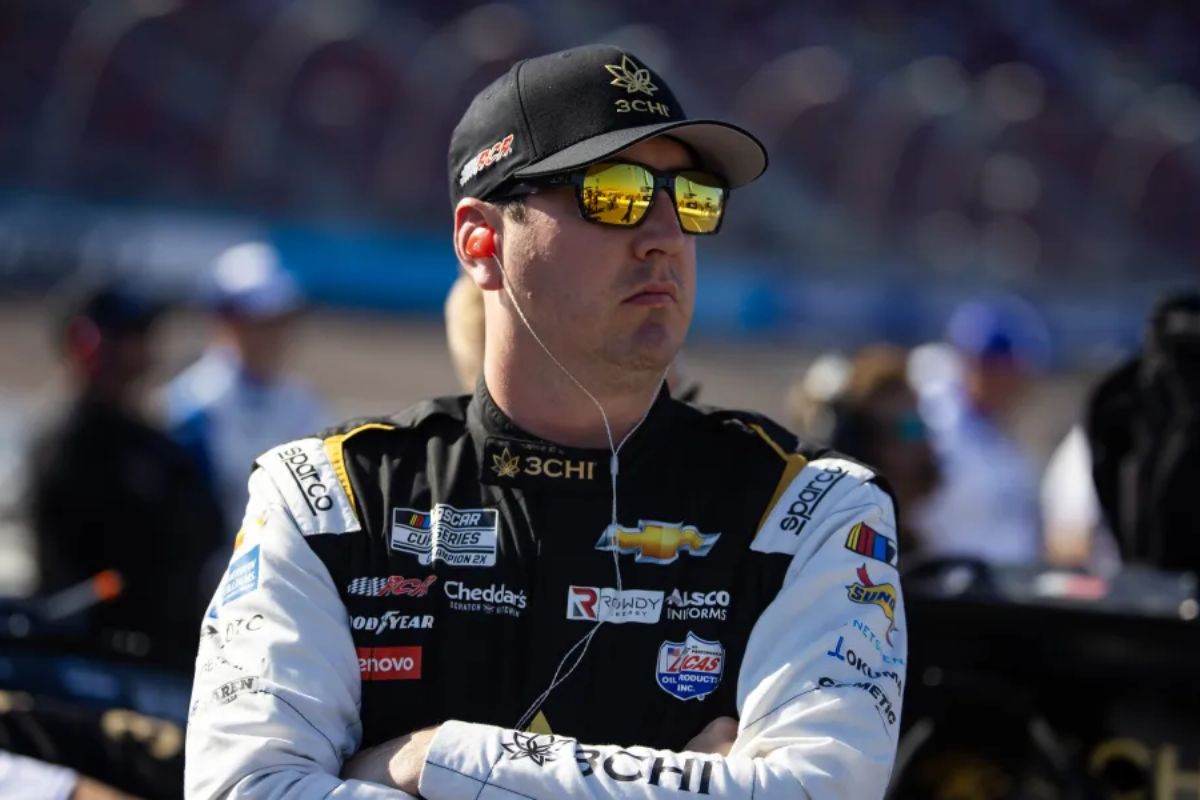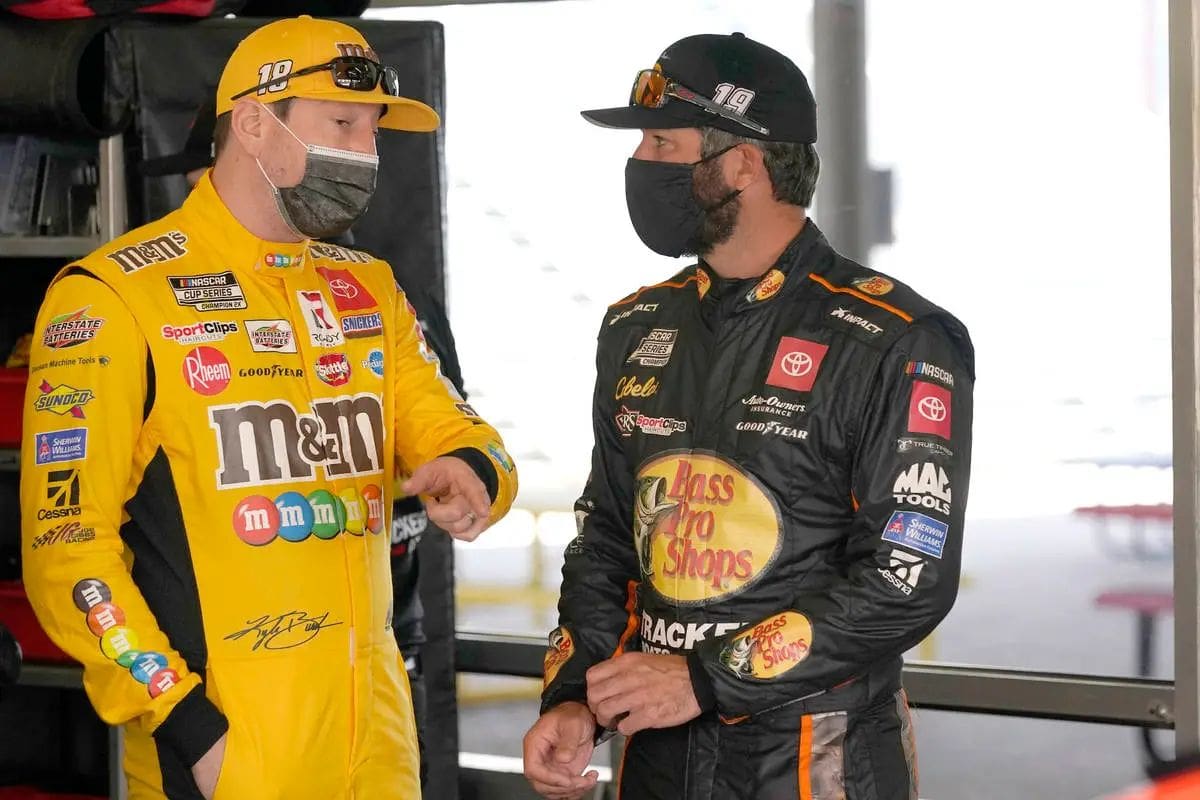Kyle Busch Calls Out Martin Truex Jr: In a recent episode at Dover International Speedway, Kyle Busch openly criticized fellow NASCAR competitor Martin Truex Jr., citing contentious defensive driving tactics and the problematic aerodynamics of the Next Gen cars. This confrontation sheds light on the issues with the Next Gen vehicle dynamics, particularly regarding how they influence racing strategies and driver interactions.
Key Takeaways
- Kyle Busch expressed frustration with Martin Truex Jr.’s air-blocking tactics at Dover International Speedway.
- Busch criticized the Next Gen car’s aerodynamics, complicating passing and racing dynamics.
- The rivalry has intensified, focusing on their on-track strategies and interactions.
- Larson suggests removing in-car cameras to reduce strategic air-blocking, impacting race outcomes.
- The ongoing drama between Busch and Truex Jr. enhances fan engagement and highlights competitive tensions in NASCAR.
Kyle Busch’s Frustrations at Dover
Despite securing a top-five finish at Dover International Speedway, Kyle Busch’s frustrations were palpable, primarily due to Martin Truex Jr.’s defensive driving tactics which he felt cost him a higher podium position. In the heat of the Wurth 400’s closing laps, Truex Jr. adeptly utilized air-blocking tactics, a technique where a driver deliberately positions their car to disturb the airflow to a pursuing vehicle, thereby hindering its ability to maintain speed and agility. This tactic, while not new to NASCAR, has gained notoriety for its effectiveness and the skill required to execute it without causing incidents.
Busch, who is no stranger to the intricate dynamics of stock car racing, found himself thwarted by Truex Jr.’s strategic placement on the track. Each time Busch attempted to close the gap, Truex Jr. adjusted his line, effectively using the aerodynamics of his car to create a buffer of turbulent air, making it increasingly difficult for Busch to sustain a stable run. This cat-and-mouse game continued through several laps, with Truex Jr. maintaining the upper hand.

Kyle Busch’s Disappointment with Next Gen Aerodynamics
Building on his frustrations from Dover, Kyle Busch’s concerns about the Next Gen aerodynamics were magnified as the performance dynamics noticeably shifted during the race. Despite securing the pole at the Wurth 400, Busch and the #8 RCR Camry XSE found themselves grappling with a sudden drop in performance as the race unfolded. This contrast between his qualifying success and race-day difficulties highlights an underlying issue with the Next Gen car’s aerodynamic properties.
“Could’ve been one spot better, but still not a win… Everything’s week to week. You’ve just got to keep working at it week-to-week. It can be different every week, you know? I’m sure the [No.] 9 [of Chase Elliott] didn’t think they were capable or in a position that they were ready for a win yet, and they got one a couple weeks ago [at Texas Motor Speedway].”-Busch
The Next Gen car, designed to level the playing field and improve competition, has introduced a new set of aerodynamic challenges that teams are still trying to decode. For Busch, the shift from a dominant qualifying position to struggling in race conditions suggests that the aerodynamic behavior of his car drastically changes under different race-day variables such as track temperature, tire wear, and turbulence from other cars. These factors seem to disproportionately affect the #8 car, indicating possible sensitivities in its aerodynamic setup that are not as pronounced in other vehicles.
“The aero blocking is just so bad. It’s so bad and everybody knows it and uses it as a defense item. We lost a straightaway to (Truex). That’s what frustrated me the most was that he was slower. He was slow and just would not give me an inch in order to be able to get by. He about wrecked us twice off of [turn] 2.”-busch
Next Gen Car’s Impact on Short Track Racing
The introduction of the Next Gen car has greatly altered the dynamics of short track racing, leading to widespread dissatisfaction among drivers and teams due to its aerodynamic characteristics. The primary complaint centers on the car’s tendency to ‘air-block,’ a phenomenon where the aerodynamic wake from a leading car creates a barrier of turbulent air, making it exceedingly difficult for trailing cars to pass. This effect is particularly pronounced on short tracks, where the reduced straightaway speeds and tighter corners intensify the impact of aerodynamic disturbances.
Drivers like Kyle Busch have been vocal about the challenges posed by the Next Gen car’s aerodynamics, noting that even strong performances are often overshadowed by the frustration of being unable to effectively navigate around competitors. This has led to races that are less about strategic driving and more about maintaining position, which can diminish the overall spectacle and competitive nature that is foundational to NASCAR’s appeal.
“The aero blocking is so bad…,” @KyleBusch reflects on a strong fourth place run but speaks on the frustrating defensive driving by drivers. #NASCAR pic.twitter.com/6eIJ95iO3v
— Noah Lewis (@Noah_Lewis1) April 28, 2024

Kyle Larson’s Perspective on Air-Blocking
Kyle Larson has expressed significant concerns about the Next Gen car’s air-blocking issues, emphasizing how this aerodynamic challenge hampers competitive racing and driver strategy on short tracks. Larson’s critique sheds light on the inherent design features of the Next Gen vehicle that may be contributing to less dynamic race outcomes, particularly on circuits where close quarters racing is prevalent.
“There was one time when he finally started moving up, and I was moving further up, trying to drag him up the racetrack. You know, I thought, maybe I could catch him off guard and shoot to the bottom.”-kyle larson
Air-blocking, a phenomenon where a car disrupts the airflow to a trailing car, making it difficult for the following driver to maintain speed and agility, has been a longstanding issue in motorsports. However, Larson points out that the Next Gen car aggravates this problem with its specific aerodynamic footprint. This results in a ‘dirty air’ effect that is more pronounced than in previous car generations, impacting the trailing driver’s ability to execute overtakes effectively.
| Aspect of Concern | Impact on Racing |
|---|---|
| Aerodynamic Design | Intensifies air-blocking, reducing overtaking opportunities |
| Competitive Strategy | Forces drivers into more conservative racing lines, limiting aggressive tactics |
| Driver Skill Utilization | Diminishes the role of driver skill in navigating and overtaking |
Larson’s Proposed Solution to Air-Blocking
Addressing the challenges of air-blocking in Next Gen cars, Kyle Larson has proposed removing in-car cameras as a potential solution. Larson’s insights stem from personal race experiences where the use of in-car cameras facilitated strategic blocking by competitors, conspicuously affecting race outcomes. This tactical advantage, as Larson elucidates, is primarily due to the improved rearward vision the cameras provide, which is markedly clearer than what can be gleaned from traditional rearview mirrors.
“I don’t know if he runs a camera but probably does, and it’s really easy, I shot down to the bottom he pulled down to the bottom so, so it’s just really easy with the cameras and the car, it’s easy to air-block.”-larson
Analyzing Larson’s proposition, it’s essential to ponder the granularity of the issue at hand. In-car cameras, originally introduced for improved viewer engagement and safety, inadvertently contribute to a form of visibility that distorts the competitive nature of racing. By enabling drivers to monitor competitors’ positions with precision, these cameras shift the focus from instinctual driving skills to a more calculated, visually aided blocking strategy. This not only impacts the authenticity of racing maneuvers but also potentially undermines the spectator’s experience by fostering predictable outcomes.
Furthermore, the removal of cameras could reintroduce a level of uncertainty in driver decision-making, compelling them to rely more on skill and less on technological aids. This could lead to more dynamic racing, where strategic foresight and driver proficiency regain prominence. However, this solution must be approached with a balanced perspective, considering both safety implications and the integral role of technology in modern sports broadcasting.

News in Brief: Kyle Busch Calls Out Martin Truex Jr
The recent altercation between Kyle Busch and Martin Truex Jr. at Dover International Speedway exemplifies the broader challenges presented by the Next Gen car in NASCAR. The aerodynamic properties of this vehicle model have greatly influenced competitive dynamics, particularly in terms of defensive driving and air-blocking strategies.This incident not only highlights the technical and strategic complexities introduced by the Next Gen car but also emphasizes the evolving nature of driver interactions and rivalries within professional racing.
Our Reader’s Queries
Q: Why is Kyle Busch called Rowdy?
A: Their son, Brexton Locke Busch, arrived on May 18, 2015. In May 2022, they celebrated the birth of daughter Lennix Key Busch. Nicknamed “Shrub” for his kinship with Kurt Busch and “Rowdy” after Days of Thunder’s Rowdy Burns.
Q: Did Martin Truex Jr retire from NASCAR?
A: At 43, Truex pondered retirement until inking a one-year extension with Joe Gibbs Racing in August.
Q: Who is replacing Kyle Busch in NASCAR?
A: As doubts linger over Ty Gibbs’ NASCAR Cup Series readiness, the Joe Gibbs scion is set for full-time action in 2023. Aged 20, Gibbs steps into the shoes of two-time Cup champion Kyle Busch at Joe Gibbs Racing
Also Read: Kyle Busch’s Blunt Dig at RCR Sparks Frustrations
